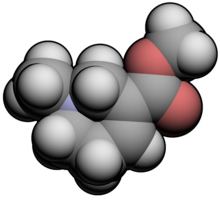
Back أريكولين Arabic Arecolin German Arecolina Spanish Arekoliini Finnish Arécoline French Arecolina Italian アレコリン Japanese അരെക്കോലിൻ Malayalam Arekolina Polish Arecolina Portuguese
 | |
 | |
| Clinical data | |
|---|---|
| Other names | Arecaline; Arecholine; Arecolin; Arecoline base; Arekolin; Methylarecaidin |
| ATC code |
|
| Legal status | |
| Legal status |
|
| Identifiers | |
| |
| CAS Number | |
| PubChem CID | |
| IUPHAR/BPS | |
| DrugBank | |
| ChemSpider | |
| UNII | |
| KEGG | |
| ChEBI | |
| ChEMBL | |
| CompTox Dashboard (EPA) | |
| ECHA InfoCard | 100.000.514 |
| Chemical and physical data | |
| Formula | C8H13NO2 |
| Molar mass | 155.197 g·mol−1 |
| 3D model (JSmol) | |
| Density | 1.0495 g/cm3 |
| Melting point | 27 °C (81 °F) |
| Boiling point | 209 °C (408 °F) |
| |
| |
| | |
Arecoline (/əˈrɛkəliːn/) is a nicotinic acid-based mild parasympathomimetic stimulant alkaloid found in the areca nut, the fruit of the areca palm (Areca catechu).[2] It is an odourless oily liquid. It can bring a sense of enhanced alertness and energy along with mild feelings of euphoria and relaxation.
- ^ "Poisons Standard October 2020". Federal Register of Legislation. The Australian Government.
- ^ Ghelardini C, Galeotti N, Lelli C, Bartolini A (2001). "M1 receptor activation is a requirement for arecoline analgesia". Farmaco. 56 (5–7): 383–385. doi:10.1016/S0014-827X(01)01091-6. hdl:2158/327019. PMID 11482763.